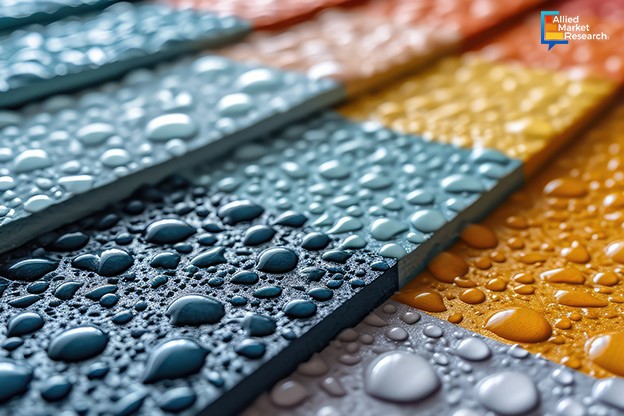How Advanced Technologies and Materials in Waterstops Boost the Profitability of Business?

28 Mar
2024
Highlights
- Introduction
- Futuristic trends in the waterstop industry
- New product launch
A waterstop is a component of concrete structures designed to prevent the passage of fluids. It typically consists of a hydrophilic or impervious strip incorporated into the concrete at joints to block the water flow. Its design functions as a fluid-tight diaphragm and is interconnected like a water bar. Waterstops find extensive application in retaining walls, basements, reservoirs, and tunnel joints, effectively inhibiting water penetration from the face of a slab or wall.
In the past few years, the waterstop industry has undergone significant transformation due to the emergence of novel and innovative products that have reshaped waterproofing solutions. The utilization of advanced materials and technologies has facilitated the creation of waterstop systems that are more durable, flexible, and simple to install. These innovations strengthened the resilience of buildings and tackled environmental issues, advocating for sustainable construction practices. The global waterstop industry is anticipated to manifest a notable CAGR of 5.1% by 2032. The growth is attributed to the robust demand from commercial sectors and the surge in penetration of waterstop in infrastructure.
Advanced polymer waterstops have gained momentum due to their superior performance
Polymer-based waterstops have gained significant traction owing to their superior performance compared to traditional materials such as PVC or rubber. These advanced polymers offer improved flexibility, durability, and resistance to chemical degradation, thereby enhancing the longevity and effectiveness of waterstop systems. Polymer-based waterstops possess exceptional adhesion to dry concrete and are designed specifically for non-moving joints. They withstand various temperature conditions without shrinking or hardening. They are designed for all-weather applications, ensuring flexibility in cold weather and pliability in hot weather without requiring heating for installation.
Advanced materials and manufacturing processes have optimized the efficiency of waterstops
Innovations in materials and manufacturing processes contribute to enhanced formulations and designs, focusing on key aspects such as durability, flexibility, and ease of installation. The development of advanced materials with superior properties, including increased resistance to wear, tear, and weathering, has led to the production of longer-lasting rubber waterstops. Moreover, innovations in manufacturing technologies have the potential to streamline production processes, thereby reducing costs and improving overall product quality. In addition, the industry's adoption of sustainable solutions reflects a broader shift toward environmentally responsible and socially conscious building practices, addressing concerns related to resource depletion and environmental impact.
How do top entities lead their supremacy in the dynamic industry?
The global waterstop industry has witnessed transformation, and frontrunners have adopted novel strategies to maintain their dominance in the competitive industry. These strategies include collaborations, partnerships, acquisitions, and new product launches. For instance, Kryton introduced a new waterstop product named Krytonite RP in January 2023, specifically designed to tackle the challenges caused by increased rainfall resulting from climate change. This blue waterstop exhibits a slower and more controlled swelling rate compared to the original Krytonite Swelling Waterstop, offering up to 24 hours of rain resistance.
Krytonite RP has maintained the superior compression sealing performance of the original product, ensuring ease of installation for contractors and builders without worrying about premature swelling issues. Krytonite RP exhibits up to 500% better performance in clean water and 400% in concrete water. This is achieved through its utilization of synthetic rubber technology and a trapezoid shape, which effectively minimizes voids in concrete. As a result, it ensures long-term waterproofing protection for construction materials, even when subjected to high hydrostatic pressure.
To conclude, the global waterstop industry has witnessed transformation due to robust demand from commercial sectors and a surge in penetration of waterstop in infrastructure. However, heightened demand from industrial sectors is expected to open new avenues for the industry in the upcoming years.
To boost the profitability of your materials business with investment opportunities and novel strategies, feel free to contact our experts!

Koyel Ghosh
Author’s Bio- Koyel Ghosh is a blogger with a strong passion and enjoys writing in miscellaneous domains, as she believes it lets her explore a wide variety of niches. She has an innate interest in creativity and enjoys experimenting with different writing styles. A writer who never stops imagining, she has been serving the corporate industry for the last five years.
Fabrics for Sun Protection: Analyzing the Investment Potential of this New Textile Industry
Avenue: Entire Library membership of Allied Market Research Reports at your disposal
- Avenue is an innovative subscription-based online report database.
- Avail an online access to the entire library of syndicated reports on more than 2,000 niche industries and company profiles on more than 12,000 firms across 11 domains.
- A cost-effective model tailored for entrepreneurs, investors, and students & researchers at universities.
- Request customizations, suggest new reports, and avail analyst support as per your requirements.
- Get an access to the library of reports at any time from any device and anywhere.
Related Post
-
How are Submarine Cables Transforming Global Connectivity with Enhanced User Experience?
-
Endoscopy Procedures: Transformations in Techniques and Applications
-
AI-Powered Video Analytics: How the Product Actually Works for enterprises
-
Painting Robots: Transforming Precision Coating and Creative Applications
-
Innovations in Pharmacovigilance Systems Advancing Patient Safety
-
Understanding Edge Security: Keeping Data Safe Near the Source
-
Exploring the Use and Advancements of 3D Laser Scanners in Professional Applications
-
Reinforcing Industrial Controls with Smarter Tools and Training








